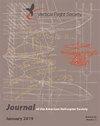多旋翼先进机动飞行器的主动噪声控制
IF 1.4
4区 工程技术
Q2 ENGINEERING, AEROSPACE
引用次数: 1
摘要
针对多旋翼先进空中机动飞行器的面内厚度噪声问题,提出了一种主动噪声控制技术。基本的概念是很少的驱动器(例如,微型扬声器)嵌入到叶片表面。它们发出加载信号来抵消厚度噪声。这个驱动信号通过Ffowcs-Williams-Hawking (FWH)公式确定。我们考虑了两个直列转子,并证明了fwhh决定的驱动信号可以在点目标处产生完美的抵消。然而,实际需要是在一个方位角区域实现降噪,而不仅仅是一个点。为了实现这种区域降噪,开发了一种优化技术,以确定由两个转子上嵌入的致动器在叶片上的分布所产生的所需致动信号。对于这里考虑的特定几何形状,这在两个旋翼向前飞行期间产生了约9db的面内厚度噪声降低。我们进一步开发了一种技术,通过分布式微致动器系统取代每个叶片上的点致动器,以实现相同的降噪目标,同时显着降低每个致动器的负载幅度。本文章由计算机程序翻译,如有差异,请以英文原文为准。
Active Noise Control of Multirotor Advanced Air Mobility Vehicles
An active noise control technology is developed here to reduce the in-plane thickness noise associated with multirotor advanced air mobility Vehicles. The basic concept is that few actuators (e.g., microspeakers) are embedded into the blade surfaces. They emit a loading signal to cancel the thickness noise. This actuation signal is determined via the Ffowcs-Williams–Hawking (FWH) formula. We considered here two inline rotors, and we showed that the FWH-determined actuation signal can produce perfect cancellation at a point target. However, the practical need is to achieve noise reduction over an azimuthal zone, not just a single point. To achieve this zonal noise reduction, an optimization technique is developed to determine the required actuation signal produced by the on-blade distribution of embedded actuators on the two rotors. For the specific geometry considered here, this produced about 9 dB reduction in the in-plane thickness noise during forward flight of the two rotors. We further developed a technology that replaces using a point actuator on each blade by distributed microactuator system to achieve the same noise reduction goal with significantly reduced loading amplitudes per actuator.
求助全文
通过发布文献求助,成功后即可免费获取论文全文。
去求助
来源期刊

Journal of the American Helicopter Society
工程技术-工程:宇航
CiteScore
4.10
自引率
33.30%
发文量
36
审稿时长
>12 weeks
期刊介绍:
The Journal of the American Helicopter Society is a peer-reviewed technical journal published quarterly (January, April, July and October) by AHS — The Vertical Flight Society. It is the world''s only scientific journal dedicated to vertical flight technology and is available in print and online.
The Journal publishes original technical papers dealing with theory and practice of vertical flight. The Journal seeks to foster the exchange of significant new ideas and information about helicopters and V/STOL aircraft. The scope of the Journal covers the full range of research, analysis, design, manufacturing, test, operations, and support. A constantly growing list of specialty areas is included within that scope. These range from the classical specialties like aerodynamic, dynamics and structures to more recent priorities such as acoustics, materials and signature reduction and to operational issues such as design criteria, safety and reliability. (Note: semi- and nontechnical articles of more general interest reporting current events or experiences should be sent to the VFS magazine
 求助内容:
求助内容: 应助结果提醒方式:
应助结果提醒方式:


